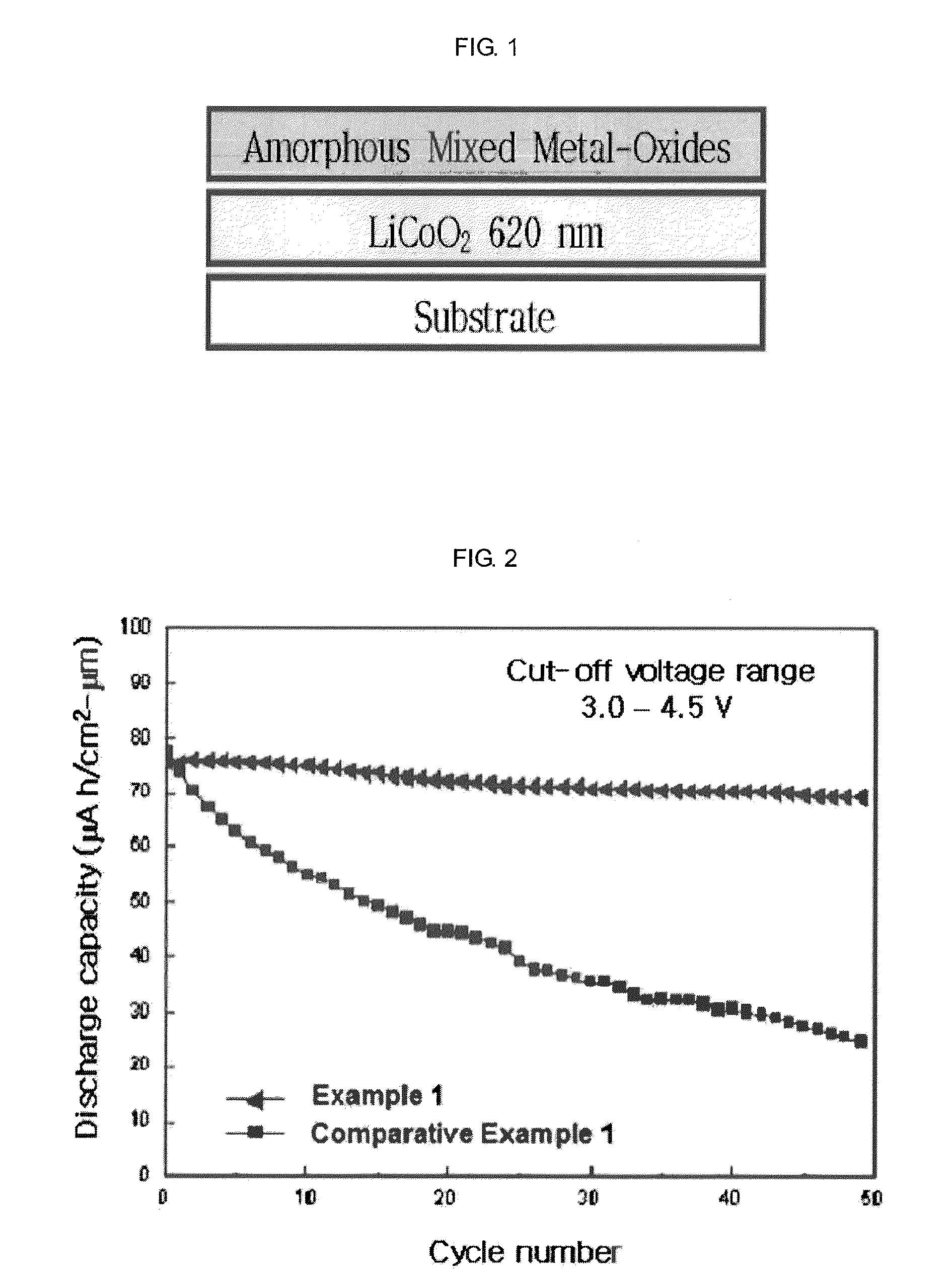Method of preparing positive active material for lithium battery
a lithium battery and active material technology, applied in the field of preparing a positive active material for a lithium secondary battery, can solve the problems of accelerating polarization, reducing the specific surface area of the electrode, and reducing the efficiency of the battery, so as to improve the electrical conductivity, increase the specific surface area of the electrode, and prevent side reactions.
- Summary
- Abstract
- Description
- Claims
- Application Information
AI Technical Summary
Benefits of technology
Problems solved by technology
Method used
Image
Examples
example 1
[0051]In this Example 1, was prepared a LiCoO2 thin film positive active material coated with mixed metal-oxides of ZrOx (1.2 at. %)+Al2O3. FIG. 1 is a structural view of an electrode surface-coated with amorphous mixed metal-oxides according to the present invention. From the lower side, the electrode was sequentially deposited with a substrate, LiCoO2 (620 nm), and amorphous mixed metal-oxides (ZrOx(1.2 at. %)+Al2O3, 5-45 nm).
[0052]Hereinafter, will be explained a method of preparing the electrode.
[0053]Firstly, LiCoO2 was deposited on the substrate with a thickness of 620 nm. In order to enhance crystallinity of the deposited positive active material, LiCoO2, a rapid thermal annealing (RTA) process was performed. This RTA process was performed at a high temperature of 650° C. at a pressure of 300 mTorr for five minutes under Ar atmospheres. In order to prevent damages due to drastic temperature changes, temperature increment and temperature decrement were performed by 1° C. per s...
example 2
[0057]A thin film positive active material having amorphous mixed metal-oxides (TiOx+Al2O3) as an upper layer according to the present invention has the following structure. From the lower side, the electrode was sequentially deposited with a substrate, LiCoO2 (620 nm), and amorphous mixed metal-oxides (TiOx(1.2 at. %)+Al2O3, 5-45 nm). The multi-layered thin film was deposited and heat-treated by the same procedures as in Example 1, except for the composition of the amorphous mixed metal-oxides (TiOx(1.2 at. %)+Al2O3), a surface coating layer. The surface coating layer used as the upper layer was controlled to have the TiOx composition of 1.2 at. %, by controlling the number of Ti chips on an Al2O3 target having a purity of 99.99%. The deposited LiCoO2 thin film positive active material was used to assemble a half-cell in the same manner as in Example 1, and then cycle performance was experimented. Referring to FIG. 3, when charge and discharge processes were performed 50 times, a L...
example 3
[0058]A thin film positive active material having amorphous mixed metal-oxides (CuOx+Al2O3) as an upper layer according to the present invention has the following structure. From the lower side, the electrode was sequentially deposited with a substrate, LiCoO2 (620 nm), and amorphous mixed metal-oxides (CuOx (1.2 at. %) / +Al2O3, 5-45 nm). The multi-layered thin film was deposited and heat-treated by the same procedures as in Example 1, except for the composition of the amorphous mixed metal-oxides (CuOx (1.2 at. %)+Al2O3), a surface coating layer. The surface coating layer used as the upper layer was controlled to have the CuOx composition of 1.2 at. %, by controlling the number of Cu chips on an Al2O3 target having a purity of 99.99%. The deposited LiCoO2 thin film positive active material was used to assemble a half-cell in the same manner as in Example 1, and then cycle performance was experimented. Referring to FIG. 4, when charge and discharge processes were performed 50 times, ...
PUM
| Property | Measurement | Unit |
|---|---|---|
| pressure | aaaaa | aaaaa |
| temperature | aaaaa | aaaaa |
| temperature | aaaaa | aaaaa |
Abstract
Description
Claims
Application Information
 Login to View More
Login to View More - R&D
- Intellectual Property
- Life Sciences
- Materials
- Tech Scout
- Unparalleled Data Quality
- Higher Quality Content
- 60% Fewer Hallucinations
Browse by: Latest US Patents, China's latest patents, Technical Efficacy Thesaurus, Application Domain, Technology Topic, Popular Technical Reports.
© 2025 PatSnap. All rights reserved.Legal|Privacy policy|Modern Slavery Act Transparency Statement|Sitemap|About US| Contact US: help@patsnap.com



